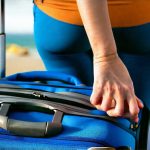Staying adequately hydrated while traveling can be surprisingly challenging. We often focus on packing essentials like clothes, toiletries, and entertainment, but overlooking hydration can lead to fatigue, headaches, decreased cognitive function, and a generally unpleasant travel experience. Travel disrupts our routines – different climates, altered schedules, less access to familiar water sources, and the stress of transit all contribute to faster dehydration than we might realize in everyday life. Many travelers underestimate how much more fluid they need when exposed to new environments and physical demands, such as walking through airports or navigating unfamiliar cities. A proactive approach to staying hydrated isn’t just about carrying a water bottle; it’s about integrating simple strategies into your travel day that ensure you maintain optimal fluid balance without adding undue stress or complexity.
Hydration impacts everything from energy levels to mood and even the ability to enjoy your destination. Dehydration can mimic other common travel ailments, making it difficult to distinguish between thirst and illness. It’s often one of the first things to suffer when we’re on the go, yet it’s also one of the easiest to address. This article will explore practical water holding strategies you can implement before, during, and after your travels – focusing on simple techniques that require minimal effort but yield significant benefits for a more enjoyable journey. We’ll move beyond simply telling you to drink more water and delve into how to make staying hydrated an effortless part of your travel experience.
Pre-Travel Hydration & Preparation
The foundation of good hydration begins before you even leave home. Don’t wait until you’re at the airport or on the plane to start thinking about fluids. The day before your trip, consciously increase your water intake – aim for a little more than your usual amount. This builds up your baseline hydration levels, giving you a buffer against the dehydrating effects of travel. Consider what type of travel you are undertaking; if it involves altitude changes or hotter climates, this pre-hydration is even more critical.
Beyond simply drinking water, think about incorporating hydrating foods into your diet in the days leading up to your trip. Fruits and vegetables with high water content like watermelon, cucumbers, oranges, and berries can contribute significantly to your overall fluid intake. Avoid excessive caffeine and alcohol in the 24 hours before travel, as these are diuretics that can lead to dehydration. Lastly, plan how you will stay hydrated during your journey – this includes choosing the right reusable bottle, considering electrolyte options (more on that later), and thinking about access points for refills along your route.
The type of water container you choose matters. A durable, leak-proof reusable water bottle is essential. Collapsible bottles are great for saving space when empty, while insulated bottles will keep your water cool for longer periods. Ensure your bottle meets airport security regulations regarding size and materials if you plan to carry it through security checkpoints. Having a dedicated hydration strategy in place before you leave takes the guesswork out of staying hydrated during travel, making it far easier to maintain consistent fluid intake.
On-the-Go Hydration Tactics
Once you’re traveling, consistency is key. Don’t rely on thirst as an indicator – by the time you feel thirsty, you are already mildly dehydrated. Set reminders on your phone or watch to prompt you to drink water at regular intervals. A small sip every 15-20 minutes is often more effective than trying to gulp down large amounts infrequently. This approach keeps your mouth moist and encourages a continuous intake of fluids.
Air travel is particularly dehydrating due to the low humidity in airplane cabins. The recirculated air draws moisture from your body, exacerbating fluid loss. Drinking water throughout the flight is crucial. Avoid excessive caffeine and alcohol on flights for the same reasons as pre-travel – they act as diuretics. If you’re prone to dry skin or eyes during flights, consider using a hydrating facial mist or eye drops in addition to drinking water. When traveling by other means (trains, buses, cars), be mindful of opportunities to refill your bottle and take regular hydration breaks.
Electrolytes play an important role in maintaining fluid balance. While plain water is essential, electrolytes – sodium, potassium, magnesium, and chloride – help your body absorb and retain fluids more effectively. During long journeys or in hot climates, consider adding electrolyte tablets or powders to your water. These are readily available at most pharmacies and health food stores. Don’t overdo it with electrolytes, however; too much can also be detrimental. Listen to your body and adjust accordingly.
Managing Hydration Through Different Travel Modes
Different modes of transportation present unique hydration challenges. Air travel, as discussed, is notoriously dehydrating due to low humidity and cabin pressure. Pack a small, TSA-approved reusable bottle and fill it after going through security. Take advantage of offered beverage service but don’t solely rely on it; request water specifically and drink frequently. Road trips offer more flexibility for hydration. Plan your route with stops at rest areas or convenience stores where you can refill your water bottle. Keep a cooler in the car with hydrating snacks like fruits and vegetables.
Train travel often allows greater freedom to move around, making it easier to stay hydrated. Walk around during long journeys and take advantage of onboard beverage services. Be mindful of potential delays, as these can increase dehydration risk. Cruises present another set of considerations. While water is generally available on board, bottled water may be expensive or limited. Consider bringing your own reusable bottle and refilling it at designated stations if available.
Dealing with Altitude & Climate Changes
Traveling to higher altitudes can significantly accelerate dehydration. The air is thinner, causing you to lose more fluids through respiration. Increase your water intake substantially when traveling to high-altitude destinations – even before you arrive. Acclimatizing gradually to the altitude helps your body adjust and reduces the risk of altitude sickness, which is often exacerbated by dehydration.
Hot climates pose a similar challenge, as you lose fluids through sweat. Drink more water than usual and consider electrolyte supplementation. Wear light-colored, loose-fitting clothing to help regulate your body temperature and reduce sweating. Avoid strenuous activity during the hottest part of the day and seek shade whenever possible. Conversely, cold weather can also be dehydrating because you may not feel as thirsty, even though your body is losing fluids through respiration and evaporation. Continue to drink water regularly, even if you don’t feel particularly thirsty.
Practical Tips for Staying Hydrated
- Carry a reusable water bottle everywhere: Make it a habit to have water readily available at all times.
- Set reminders: Use your phone or watch to remind yourself to drink water every 15-20 minutes.
- Incorporate hydrating foods: Fruits and vegetables with high water content contribute to overall fluid intake.
- Avoid diuretics: Limit caffeine and alcohol consumption, especially before and during travel.
- Consider electrolytes: Supplementing with electrolytes can help your body absorb and retain fluids more effectively.
- Listen to your body: Pay attention to signs of dehydration – fatigue, headache, dizziness – and adjust your fluid intake accordingly.
- Refill often: Take advantage of opportunities to refill your water bottle at airports, rest stops, or designated stations.
By incorporating these simple strategies into your travel routine, you can ensure that you stay adequately hydrated and enjoy a more comfortable and fulfilling journey. Remember, proactive hydration isn’t just about avoiding discomfort; it’s about optimizing your energy levels, cognitive function, and overall well-being while exploring new destinations. For those planning longer trips, consider reviewing meal strategies for extended travel to support overall health.
Maintaining adequate hydration is particularly crucial during air travel due to the low humidity. To learn more about managing potential issues related to urinary function while traveling, explore strategies for planning safe travel meals.
Electrolytes are vital for maintaining fluid balance, especially during long journeys or in hot climates. You can also learn about the benefits of optimal hydration practices for high-activity days to enhance your body’s ability to absorb and retain fluids.
If you’re planning a trip involving significant altitude changes, it’s important to understand how this impacts hydration. Reviewing preparations for active travel days will help you prepare effectively.
Don’t underestimate the importance of choosing the right water container; a reusable bottle is essential. Consider checking out hydration strategies for bladder support to learn more about optimizing your fluid intake.
To further enhance your travel experience and minimize potential discomfort, it’s helpful to understand how different modes of transportation affect hydration levels. You might find post-travel recovery techniques beneficial for restoring balance after a journey.
Finally, remember that proactive hydration isn’t just about avoiding discomfort; it’s about optimizing your health and well-being while exploring new destinations. Consider reviewing hydration snack options for frequent travelers to support consistent fluid intake.





















